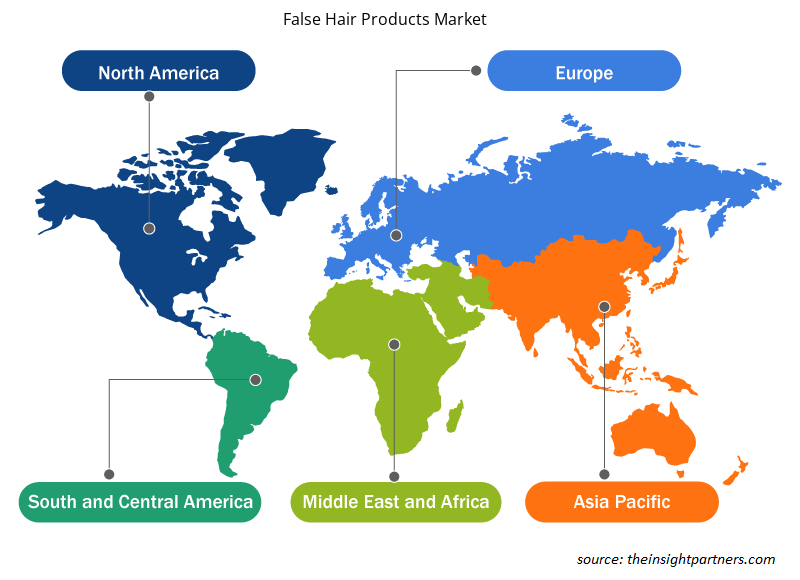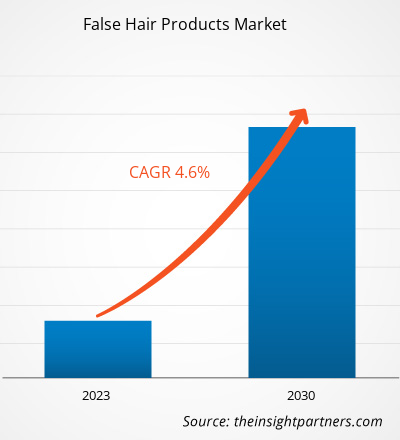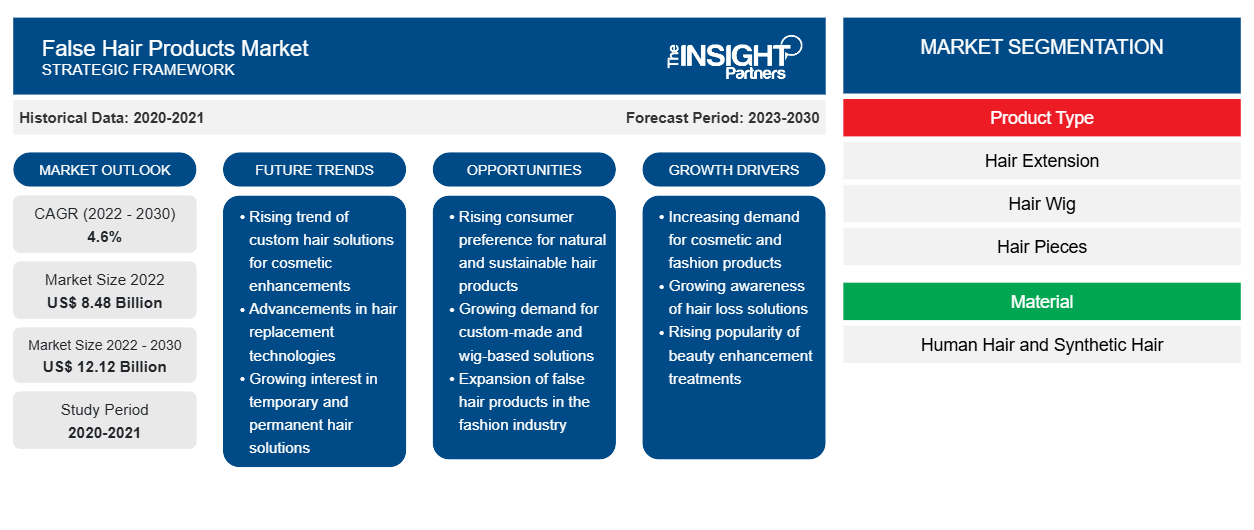[Rapport de recherche] La taille du marché des produits pour cheveux artificiels était évaluée à 8 484,19 millions USD en 2022 et devrait atteindre 12 115,21 millions USD d'ici 2030 ; on estime qu'elle enregistrera un TCAC de 4,6 % de 2022 à 2030.
Informations sur le marché et point de vue des analystes :
Les produits pour cheveux artificiels sont des postiches artificiels conçus pour améliorer ou modifier l'apparence naturelle des cheveux. Ces produits sont disponibles sous diverses formes, notamment des extensions de cheveux, des perruques et des postiches. Ils sont souvent utilisés pour ajouter de la longueur, du volume ou des couleurs différentes aux cheveux. Les produits pour cheveux artificiels peuvent être fabriqués à partir de fibres synthétiques ou de cheveux humains naturels, et ils offrent aux individus la possibilité d'expérimenter différentes coiffures sans s'engager dans des changements permanents. Bien que ces produits puissent offrir des transformations instantanées, il est essentiel de choisir des options de haute qualité et de les utiliser correctement pour obtenir un look naturel et homogène.
Moteurs de croissance et défis :
La chimiothérapie, la radiothérapie et d’autres traitements médicaux contre le cancer sont conçus pour éliminer les cellules à division rapide, qui incluent malheureusement les follicules pileux. En conséquence, les patients subissant un traitement contre le cancer subissent souvent une perte de cheveux importante, ce qui peut être émotionnellement pénible et affecter leur estime de soi.
Selon les estimations du Centre international de recherche sur le cancer (CIRC), en 2018, 17 millions de nouveaux cas de cancer et 9,5 millions de décès par cancer ont été signalés dans le monde. D’ici 2040, les nouveaux cas de cancer et les décès par cancer devraient atteindre respectivement 27,5 millions et 16,3 millions, en raison de l’évolution des modes de vie et des habitudes alimentaires, de la consommation d’alcool et du tabagisme. Le fardeau sera probablement encore plus lourd dans les pays en transition économique à l’avenir en raison de la consommation croissante d’aliments malsains, de la dépendance croissante au tabac et de l’inactivité physique.
La demande de produits capillaires artificiels a considérablement augmenté en raison de la perte de cheveux répandue causée par les traitements contre le cancer. Les produits capillaires artificiels tels que les perruques, les extensions, etc. offrent une solution efficace aux patients qui cherchent à conserver leur apparence et à retrouver un certain sentiment de normalité au milieu de leur combat contre le cancer. Pour répondre aux besoins des patients atteints de cancer, les acteurs du marché des produits capillaires artificiels proposent une large gamme de produits, notamment des perruques en cheveux naturels, des perruques synthétiques, des postiches en cheveux synthétiques, des postiches en cheveux naturels et des modèles personnalisés. Les fabricants de produits capillaires artificiels ont amélioré la qualité et le confort de leurs produits, garantissant ainsi aux patients atteints de cancer l'accès à des produits capillaires artificiels confortables et réalistes qui contribuent à renforcer leur confiance en eux pendant une période difficile.
La croissance du marché des produits capillaires artificiels est également stimulée par une sensibilisation et une compréhension croissantes du cancer et de ses effets sur les patients. Les organisations de soutien, les centres médicaux et les initiatives communautaires ont activement promu la disponibilité et les avantages des perruques et des extensions pour les patients atteints de cancer, les encourageant à adopter les produits capillaires artificiels comme une option d'autonomisation. La Fondation Cherian (TCF), une fondation caritative privée basée à Chennai, en Inde, a lancé une campagne intitulée « Gift Hair Gift Confidence ». Dans le cadre de cette campagne, la fondation s'est associée à Dabur Amla Hair Oil pour organiser une campagne de dons de cheveux et de perruques à l'occasion de la Journée mondiale contre le cancer 2022. La campagne visait à éradiquer la stigmatisation autour du cancer et à encourager la détection précoce du cancer chez les femmes. Cette campagne s'engage à fournir gratuitement 150 perruques aux patients atteints de cancer défavorisés pour les aider à affronter la vie avec une confiance renouvelée. Par conséquent, l'augmentation des cas de perte de cheveux dus aux traitements contre le cancer stimule la croissance du marché des produits capillaires artificiels.
Les pratiques contraires à l’éthique dans l’industrie capillaire ont donné lieu à des activités interdites telles que la vente illégale de cheveux et la réduction de la rémunération des ouvriers travaillant dans l’industrie capillaire. La vente principale de cheveux provient de petits agents et médiateurs qui parcourent les villages de pays comme la Chine, l’Inde et les pays d’Europe de l’Est, offrant aux femmes pauvres de petites sommes d’argent pour se séparer de leurs cheveux. Selon des recherches récentes, les personnes confrontées à des difficultés financières dans les régions à faible revenu vendent leurs cheveux. En Inde, diverses pratiques contraires à l’éthique liées à la vente de cheveux ont lieu. Par exemple, les enfants des bidonvilles sont induits en erreur en se rasant la tête en échange de jouets ; parfois, les maris obligent leurs femmes à vendre leurs cheveux. En outre, même les contrebandiers se livrent au commerce illégal de cheveux humains bruts d’origine indienne vers la Chine par voie terrestre. La contrebande par voie terrestre élimine plus de 28 % des droits d’importation tout en payant une misère aux enfants qui séparent et isolent les souches de cheveux dans les cheveux humains bruts et non traités. Ainsi, tous les facteurs susmentionnés ont un impact négatif sur le marché mondial des produits capillaires artificiels.
Personnalisez ce rapport en fonction de vos besoins
Vous bénéficierez d'une personnalisation gratuite de n'importe quel rapport, y compris de certaines parties de ce rapport, d'une analyse au niveau des pays, d'un pack de données Excel, ainsi que d'offres et de remises exceptionnelles pour les start-ups et les universités.
-
Obtenez les principales tendances clés du marché de ce rapport.Cet échantillon GRATUIT comprendra une analyse de données, allant des tendances du marché aux estimations et prévisions.
Segmentation et portée du rapport :
Le marché mondial des produits capillaires artificiels est segmenté en fonction du type de produit, du matériau, de l'utilisateur final, du canal de distribution et de la géographie. Le marché des produits capillaires artificiels, en fonction du type de produit, est segmenté en extensions de cheveux , perruques de cheveux et postiches. En fonction du matériau, le marché des produits capillaires artificiels est divisé en cheveux humains et cheveux synthétiques. En fonction de l'utilisateur final, les marchés sont segmentés en hommes, femmes et enfants. En fonction du canal de distribution, le marché est segmenté en supermarchés et hypermarchés, magasins spécialisés, vente au détail en ligne et autres. En fonction de la géographie, le marché mondial des produits capillaires artificiels est largement segmenté en Amérique du Nord, Europe, Asie-Pacifique, Moyen-Orient et Afrique, et Amérique du Sud et Amérique centrale.
Analyse segmentaire :
En fonction du type de produit, le marché des produits pour cheveux artificiels est segmenté en extensions de cheveux, perruques et postiches. Le segment des extensions de cheveux devrait enregistrer le TCAC le plus élevé au cours de la période de prévision. Les extensions de cheveux sont devenues une solution révolutionnaire dans le monde de la beauté et de la mode. Avec la possibilité d'ajouter instantanément de la longueur, du volume et même des reflets aux cheveux naturels, elles offrent un moyen polyvalent d'obtenir une variété de looks. Le marché des extensions de cheveux connaît une croissance rapide en raison de la demande croissante de changements de coiffure rapides et temporaires. Les plateformes de médias sociaux, les influenceurs de la beauté et les célébrités présentent régulièrement différentes coiffures, incitant les individus à expérimenter leur apparence. De plus, les extensions de cheveux s'adressent à celles qui ont les cheveux plus courts et aux personnes aux cheveux fins ou clairsemés qui recherchent un volume supplémentaire. Alors que la qualité et la variété des extensions continuent de s'améliorer et que les gens adoptent l'idée d'utiliser des extensions comme moyen d'expression créative, le marché des produits pour cheveux artificiels pour le segment des extensions de cheveux devrait se développer dans les années à venir.
Analyse régionale :
Le marché des produits capillaires artificiels est segmenté en cinq régions clés : l'Amérique du Nord, l'Europe, l'Asie-Pacifique, l'Amérique du Sud et l'Amérique centrale, ainsi que le Moyen-Orient et l'Afrique. L'Amérique du Nord a dominé le marché mondial des produits capillaires artificiels, et le marché régional a représenté 2 995,52 millions USD en 2022. L'Europe est un deuxième contributeur majeur détenant plus de 29 % des parts du marché mondial. L'Asie-Pacifique devrait enregistrer un TCAC considérable de plus de 5 % au cours de la période de prévision. Le marché des produits capillaires artificiels de l'Asie-Pacifique est segmenté en Chine, en Inde, au Japon, en Corée du Sud et en Australie. Un nombre croissant de personnes confrontées à la perte de cheveux en Inde, en Chine et au Japon en raison du stress, de maladies auto-immunes (alopécie), de la pollution, d'infections fongiques, de cancer, de déséquilibre hormonal et du syndrome des ovaires polykystiques (POS) propulse la demande de produits capillaires artificiels comme solution pour améliorer l'apparence. Les progrès des techniques et des matériaux de fabrication de perruques et d'extensions ont permis d'obtenir des perruques de meilleure qualité et d'apparence réaliste, incitant les consommateurs à les choisir. Evergreen Products Group Ltd, Henan Ruimei Products Co Ltd, Artnature Co Ltd et Lordhair Co Ltd font partie des principaux fabricants qui dominent le marché des produits capillaires artificiels en Asie-Pacifique. En outre, ces fabricants leaders de la région cherchent continuellement à étendre leur présence sur le marché.
Aperçu régional du marché des produits pour cheveux artificiels
Les tendances régionales et les facteurs influençant le marché des produits pour faux cheveux tout au long de la période de prévision ont été expliqués en détail par les analystes d’Insight Partners. Cette section traite également des segments et de la géographie du marché des produits pour faux cheveux en Amérique du Nord, en Europe, en Asie-Pacifique, au Moyen-Orient et en Afrique, ainsi qu’en Amérique du Sud et en Amérique centrale.

- Obtenez les données régionales spécifiques au marché des produits pour faux cheveux
Portée du rapport sur le marché des produits pour cheveux artificiels
| Attribut de rapport | Détails |
|---|---|
| Taille du marché en 2022 | 8,48 milliards de dollars américains |
| Taille du marché d'ici 2030 | 12,12 milliards de dollars américains |
| Taux de croissance annuel moyen mondial (2022-2030) | 4,6% |
| Données historiques | 2020-2021 |
| Période de prévision | 2023-2030 |
| Segments couverts |
Par type de produit
|
| Régions et pays couverts |
Amérique du Nord
|
| Leaders du marché et profils d'entreprises clés |
|
Densité des acteurs du marché des produits capillaires artificiels : comprendre son impact sur la dynamique commerciale
Le marché des produits pour faux cheveux connaît une croissance rapide, tirée par la demande croissante des utilisateurs finaux en raison de facteurs tels que l'évolution des préférences des consommateurs, les avancées technologiques et une plus grande sensibilisation aux avantages du produit. À mesure que la demande augmente, les entreprises élargissent leurs offres, innovent pour répondre aux besoins des consommateurs et capitalisent sur les tendances émergentes, ce qui alimente davantage la croissance du marché.
La densité des acteurs du marché fait référence à la répartition des entreprises ou des sociétés opérant sur un marché ou un secteur particulier. Elle indique le nombre de concurrents (acteurs du marché) présents sur un marché donné par rapport à sa taille ou à sa valeur marchande totale.
Les principales entreprises opérant sur le marché des produits pour faux cheveux sont :
- Groupe de produits Evergreen Ltée
- Hairuwear Inc
- Henan Ruimei Products Co., Ltd.
- Artnature Co. Ltd.
- Shake-N-Go Inc
Avis de non-responsabilité : les sociétés répertoriées ci-dessus ne sont pas classées dans un ordre particulier.

- Obtenez un aperçu des principaux acteurs du marché des produits pour faux cheveux
Impact de la pandémie de COVID-19 :
La pandémie de COVID-19 a initialement entravé le marché mondial des produits capillaires artificiels en raison de la fermeture des unités de fabrication, de la pénurie de main-d'œuvre, de la perturbation des chaînes d'approvisionnement et de l'instabilité financière. La perturbation de diverses industries due au ralentissement économique provoqué par l'épidémie de COVID-19 a restreint l'approvisionnement en produits capillaires artificiels. Divers magasins de produits capillaires artificiels ont été fermés. Cependant, les entreprises gagnent du terrain car les restrictions précédemment imposées ont été assouplies dans divers pays. De plus, l'introduction de vaccins contre la COVID-19 par les gouvernements de différents pays a amélioré la situation, entraînant une augmentation des activités commerciales dans le monde entier. Plusieurs marchés, dont le marché des produits capillaires artificiels, ont enregistré une croissance après l'assouplissement des mesures de confinement et des restrictions de mouvement.
Paysage concurrentiel et entreprises clés :
Evergreen Products Group Ltd, Hairuwear Inc, Henan Ruimei Products Co Ltd, Artnature Co Ltd, Shake-N-Go Inc, Papillon Hair World, Locks & Bonds, Klix Hair Inc, Easihair Pro et Balmain Hair Group BV font partie des principaux acteurs opérant sur le marché mondial des produits pour cheveux artificiels.
- Analyse historique (2 ans), année de base, prévision (7 ans) avec TCAC
- Analyse PEST et SWOT
- Taille du marché Valeur / Volume - Mondial, Régional, Pays
- Industrie et paysage concurrentiel
- Ensemble de données Excel
Rapports récents
Rapports connexes
Témoignages
Raison d'acheter
- Prise de décision éclairée
- Compréhension de la dynamique du marché
- Analyse concurrentielle
- Connaissances clients
- Prévisions de marché
- Atténuation des risques
- Planification stratégique
- Justification des investissements
- Identification des marchés émergents
- Amélioration des stratégies marketing
- Amélioration de l'efficacité opérationnelle
- Alignement sur les tendances réglementaires























 Obtenez un échantillon gratuit pour - Marché des produits pour faux cheveux
Obtenez un échantillon gratuit pour - Marché des produits pour faux cheveux